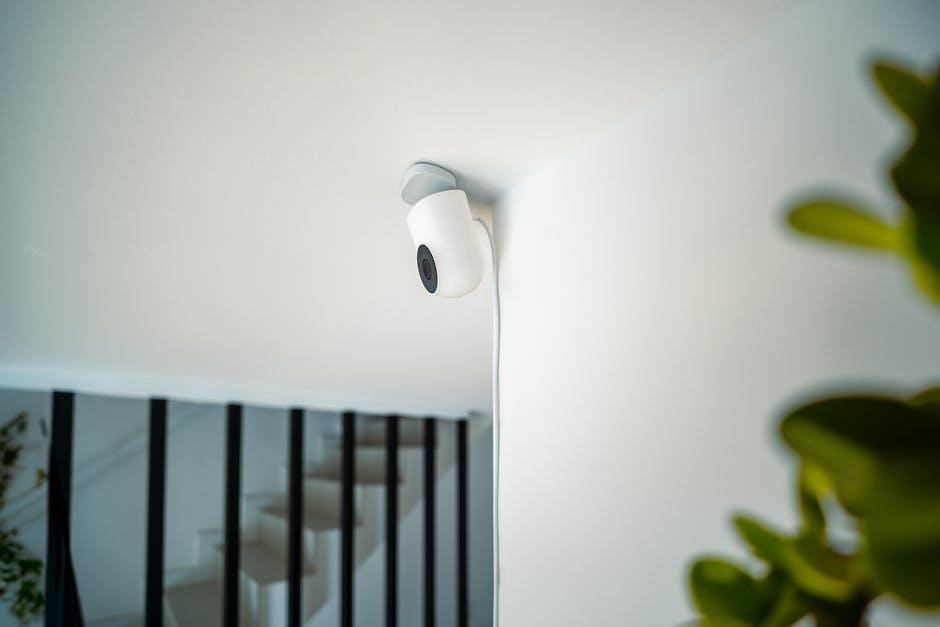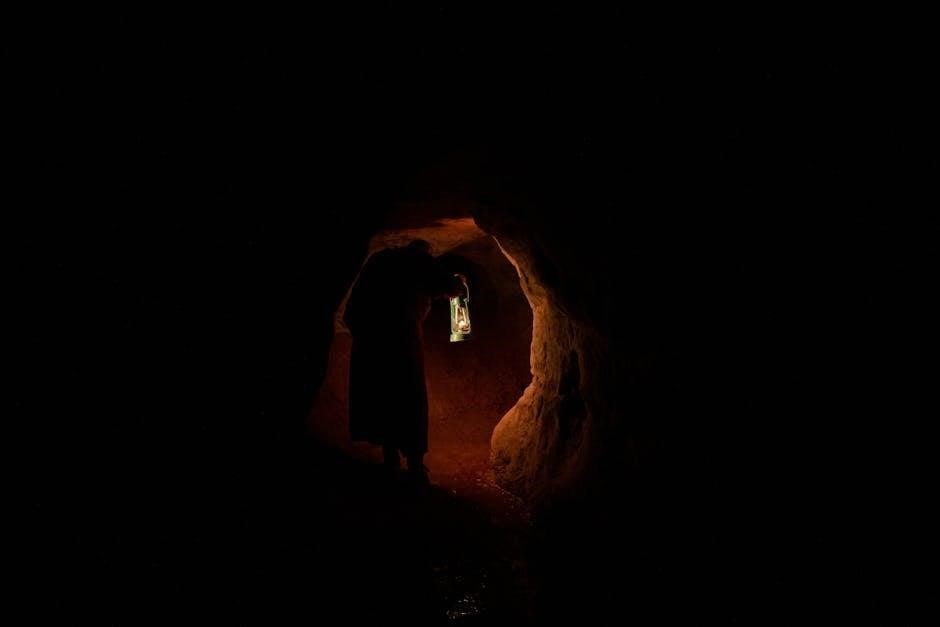Trailer light wiring is essential for ensuring safety and functionality when towing. It involves connecting lights and brakes to your vehicle’s electrical system. This guide provides a comprehensive overview of the process, covering basic principles, components, and step-by-step instructions to help you install and maintain trailer lighting systems effectively.
1.1 Importance of Proper Trailer Lighting
Proper trailer lighting is crucial for safety, visibility, and legal compliance. It ensures that other drivers can see your trailer, especially at night or in low-light conditions, reducing the risk of accidents. Trailer lights, including brake lights, turn signals, and running lights, help communicate your intentions to other road users. Improper or faulty lighting can lead to fines, accidents, or towing issues. Additionally, it enhances overall visibility, making towing safer and more manageable. Always ensure your trailer lighting system is correctly installed and functioning to avoid potential hazards and legal penalties while on the road.
1.2 Overview of Trailer Wiring Systems
Trailer wiring systems are standardized to ensure compatibility and safety. They typically consist of a harness with color-coded wires connecting to your vehicle’s electrical system. The most common setups include 4-pin and 7-pin connectors, catering to basic and complex trailer needs. Each wire serves a specific function, such as powering brake lights, turn signals, and running lights. Proper connections ensure all lights function synchronously with your vehicle, enhancing visibility and safety. Understanding your trailer’s wiring system is key to troubleshooting and maintaining reliable operation while towing.

Understanding Trailer Light Wiring Color Codes
Trailer wiring color codes are standardized to ensure safety and functionality. Each wire color corresponds to a specific function, such as braking, turning, or lighting, aiding proper installation and troubleshooting.
2.1 Standard Color Coding for Trailer Wires
Trailer wiring systems use standardized color codes to ensure consistency and safety. The white wire is the ground, while the black wire provides 12V power. Red is for brakes, yellow for left turn/brake, green for right turn/brake, blue for auxiliary power, and brown for tail lights. These colors help identify functions quickly, minimizing errors during installation. Always refer to a wiring diagram for specific configurations, as variations may exist. Properly matching colors ensures lights, brakes, and electronics function correctly, enhancing safety and reliability while towing.
2.2 Functions of Each Wire
Each trailer wire serves a specific function, ensuring proper lighting and safety. The white wire is the ground, providing a safe path for electrical current. Black supplies 12V power, while red controls brakes. Yellow handles left turn signals and brakes, green manages right turn signals and brakes, and brown powers tail lights. Blue is for auxiliary power, often used for interior lights or accessories. These functions ensure lights and brakes operate correctly, enhancing visibility and safety while towing. Always match wires by color and function to avoid system malfunctions and ensure compliance with safety standards.
Tools and Materials Needed
Essential tools include a wiring harness, electrical tester, wire cutters, and connectors. Materials like electrical tape, heat shrink tubing, and replacement bulbs ensure a safe and durable installation.
3.1 Essential Tools for Wiring
A wiring harness is crucial for connecting your trailer lights to your vehicle’s electrical system. An electrical tester helps identify live wires and diagnose issues. Wire cutters and strippers are necessary for trimming and preparing wires. Connectors ensure secure and corrosion-resistant links between wires. Pliers and screwdrivers aid in tightening connections, while electrical tape and heat shrink tubing provide insulation. A multimeter can measure voltage and current, ensuring proper electrical flow. Lastly, replacement bulbs and fuses are handy for addressing faulty lights or overloaded circuits. These tools are indispensable for a safe and efficient wiring process.
3.2 Required Materials for Installation
To install trailer light wiring, you’ll need a trailer wiring harness, which connects your vehicle to the trailer’s lights. Trailer lights, including brake, turn signal, and taillights, are essential. Connectors and adapters ensure compatibility between your vehicle and trailer. Durable, weatherproof wiring is necessary for outdoor use. Fuses and circuit protectors safeguard against electrical overloads. Mounting hardware, like brackets and clips, secures the harness and lights. A wiring diagram is crucial for proper connections. These materials ensure a safe and functional trailer lighting system.

Safety Precautions
Always disconnect the battery before starting work to avoid electrical shocks. Use a circuit tester to identify live wires. Handle wiring carefully to prevent damage. Ensure all connections are secure to avoid short circuits. Follow wiring diagrams for proper installation and safety.
4.1 Electrical Safety Measures
When working with trailer light wiring, always disconnect the battery to prevent electrical shocks. Use a circuit tester to identify live wires before handling them. Avoid touching bare wires or connections to prevent short circuits. Ensure all connections are secure and insulated. Follow the wiring diagram to connect circuits correctly. Never overload the electrical system, as this can cause fires. Wear protective gloves and safety glasses when working with electrical components. Keep the work area well-lit to spot potential hazards. Test the system thoroughly after installation to ensure proper function. If unsure, consult a professional to avoid risks.
4.2 Protecting Your Vehicle and Trailer
To protect your vehicle and trailer, ensure all wiring connections are secure and insulated. Use a high-quality wiring harness designed for your specific setup. Regularly inspect wires for signs of wear or damage, and repair or replace them immediately. Avoid overloading the trailer with weight, as this can strain the electrical system. Keep the trailer lights and connectors clean and dry to prevent corrosion. Use protective sleeves or tape to shield wires from abrasion. Always test the brakes and lighting systems before towing to ensure everything functions safely and efficiently.
Step-by-Step Installation Guide
This guide provides a comprehensive walkthrough of installing trailer light wiring, covering preparation, harness connection, light installation, and final configurations to ensure safe and proper functionality.
5.1 Preparing Your Vehicle and Trailer
Before starting the installation, ensure your vehicle and trailer are ready. Gather all necessary tools and materials, including wiring harnesses, connectors, and electrical testers. Inspect the vehicle’s tow hitch and trailer connectors for damage or corrosion. Clean any dirty or corroded surfaces to ensure proper electrical connections. Verify that the trailer’s braking system is functional and aligned with your vehicle’s electrical setup. Consult your vehicle’s manual to locate the wiring system and ensure compatibility with the trailer’s lighting configuration. Disconnect the battery to prevent short circuits during the process. Proper preparation ensures a safe and efficient installation process.
5.2 Connecting the Wiring Harness
Connecting the wiring harness involves linking your vehicle’s electrical system to the trailer’s lights and brakes. Start by locating the vehicle’s wiring system, often near the tow hitch. Use a wiring diagram to understand the color coding, which typically includes green (right turn/brake), yellow (left turn/brake), brown (running lights), and white (ground). Match these colors carefully to avoid electrical issues. Secure connections using proper connectors, crimping, or soldering, and insulate them to prevent short circuits. Test connections with a test light or multimeter to ensure conductivity. Finally, fasten the harness securely to prevent damage while towing, ensuring all lights function correctly for safety.
5.3 Installing Trailer Lights
Installing trailer lights begins with mounting the light assemblies to the trailer frame, ensuring they are level and securely fastened. Connect the wires to the corresponding terminals, matching the color codes for proper function. Use a test light to verify each light operates correctly. Ensure all connections are insulated and protected from moisture. Double-check the placement of brake, turn, and running lights to meet legal requirements. Finally, perform a physical inspection to confirm all lights are firmly attached and functioning as intended. Proper installation ensures safety and compliance with regulations while towing.
5.4 Connecting to the Battery
Connecting the trailer wiring to the vehicle’s battery ensures power for the lights and brakes. Locate the battery and identify the positive terminal. Install a circuit breaker or fuse close to the battery to protect the wiring system. Use heavy-duty wires to connect the trailer harness to the battery, ensuring proper gauge for the current draw. Secure all connections with heat-shrink tubing or electrical tape. Test the system to confirm all lights and brakes function correctly. Avoid connecting directly to the battery without a breaker, as this can cause electrical fires. Always follow safety guidelines when working with live electrical systems.
Troubleshooting Common Issues
Troubleshooting trailer light issues often involves checking for loose connections, blown fuses, or damaged wires. Use an electrical tester to identify faults and ensure all lights function properly.
6.1 Identifying Malfunctioning Lights
Identifying malfunctioning trailer lights is crucial for safety and compliance. Start by inspecting each light individually, checking for dimming, flickering, or complete failure. Test brake lights, turn signals, and running lights separately to isolate issues. Use an electrical tester to verify power flow to each bulb. Common problems include corroded connections, blown fuses, or damaged wires. Visually inspect harnesses for signs of wear or damage. If a light fails to illuminate, check the bulb and its socket for proper connectivity. Always ensure the trailer is properly connected to the vehicle’s wiring system before testing.
6.2 Diagnosing Wiring Problems
Diagnosing wiring issues requires a systematic approach. Start by using an electrical tester to check for power at each connector. Look for short circuits, open circuits, or faulty ground connections. Inspect the wiring harness for signs of damage, such as cuts, burns, or corrosion. Test the vehicle and trailer connectors separately to identify where the issue originates. Use a multimeter to verify continuity between wires and ensure proper voltage levels. Corroded or loose connections are common culprits, so clean and tighten all terminals. If a specific function fails, trace the wire back to its source to locate the fault.
6.3 Resolving Connectivity Issues
Resolving connectivity issues starts with checking for corrosion or loose connections. Clean terminals with sandpaper and apply dielectric grease to prevent future corrosion. Verify the wiring harness is securely attached to both the vehicle and trailer. If a wire is damaged, splice in a new section or replace it entirely. Use a multimeter to ensure proper continuity and voltage. Check the trailer plug for correct alignment and function. If issues persist, test the system with the trailer connected to isolate the problem. Ensuring all connections are tight and corrosion-free will restore proper functionality to your trailer lighting system.

Maintenance and Repair
Regular maintenance ensures trailer lights function safely and reliably. Inspect wires for damage, clean connections, and tighten loose terminals. Replace worn-out components promptly to prevent system failures.
7.1 Regular Checks for Trailer Lighting
Regular inspections are crucial for ensuring trailer lights function properly. Start by visually inspecting all lights, wires, and connections for damage, wear, or corrosion. Use a multimeter to test the electrical continuity of wires and connections. Clean any corroded terminals to maintain proper conductivity. Check the trailer plug and socket for damage or misalignment, ensuring they are securely connected. Test each light individually—brake lights, turn signals, and running lights—to confirm they activate correctly when connected to your vehicle. Regular checks help prevent safety hazards and legal issues while towing.
7.2 Repairing Damaged Wires
Repairing damaged wires is essential for maintaining reliable trailer lighting. Start by identifying the damaged section using a multimeter to test continuity. Cut out the damaged part, then strip the insulation from both ends. Use solder or heat-shrink connectors to splice the wires securely. Apply electrical tape or shrink tubing for protection. Ensure all connections are tight and insulated to prevent short circuits. Test the circuit to confirm proper functionality. Regularly inspect wires for signs of wear, and address issues promptly to avoid further damage. Proper repairs ensure safety and prevent electrical failures while towing.
7;3 Replacing Faulty Components
Replacing faulty components is crucial for maintaining trailer light functionality. Start by identifying the malfunctioning part using a multimeter or tester. Once located, disconnect the power supply and remove the defective component. Install a new, compatible replacement, ensuring secure connections; Tighten all terminals and double-check for proper fit. Apply dielectric grease to prevent corrosion. Finally, test the system to confirm all lights and functions work correctly. Regularly inspect components for wear or damage, and replace them promptly to avoid system failures. Always follow manufacturer guidelines for replacement parts and procedures to ensure reliability and safety on the road.
Trailer light wiring is essential for safety and functionality. Proper installation and maintenance ensure reliable performance. Follow guidelines and best practices to keep your trailer lights working effectively.
8.1 Summary of Key Points
Proper trailer light wiring is crucial for safety, functionality, and legal compliance. Understanding color codes and wire functions ensures correct connections. Essential tools and materials, along with safety precautions, protect your vehicle and trailer. A step-by-step installation guide helps avoid errors. Troubleshooting common issues, like faulty lights or wiring problems, ensures reliable operation. Regular maintenance and checks prolong system longevity. By following these guidelines, you can ensure your trailer lighting works effectively, enhancing safety and convenience while towing. Mastering these elements guarantees a secure and efficient setup for years of trouble-free use.
8.2 Final Tips for Safe and Effective Wiring
Always use the correct tools and materials to ensure reliable connections. Test each light and function before towing to confirm everything works. Protect wires from damage by routing them securely and using protective sleeves. Refer to wiring diagrams for accuracy and consistency. Avoid overloading circuits to prevent electrical failures. Regularly inspect and clean connections to maintain conductivity. If unsure, consult a professional or trusted guide. By following these tips, you can ensure a safe, durable, and efficient trailer wiring system that performs optimally under various conditions. Proper installation and maintenance are key to long-term reliability and safety on the road.

Additional Resources
Visit trusted websites like matt-jackson.com for advanced search operators and wiring diagrams. Explore online forums and tutorials for detailed guides and troubleshooting tips. Utilize manufacturer websites for specific instructions and diagrams to ensure accuracy and safety in your trailer wiring projects.
9.1 Recommended Wiring Diagrams
For accurate trailer light wiring, use diagrams from reputable sources like matt-jackson.com or manufacturer websites. These diagrams detail connections for 4-pin, 5-pin, and 7-pin plugs, ensuring proper setup for brakes, lights, and auxiliary power. They often include color-coded wires, making it easier to identify functions like tail lights, turn signals, and brake lights. Diagrams also cover grounding techniques and connector types, reducing the risk of electrical issues. Always refer to diagrams specific to your vehicle and trailer setup for precise instructions. This ensures safety and compliance with electrical standards, avoiding potential hazards during towing.
9.2 Online Tutorials and Guides
Online tutorials and guides provide step-by-step instructions for trailer light wiring, often including videos and diagrams. Websites like YouTube and specialized forums offer detailed walkthroughs, covering topics like wiring color codes and connector installation. Many guides emphasize safety tips and troubleshooting common issues. Advanced search operators can help find specific tutorials, such as those for 7-pin plugs or brake controllers. These resources cater to both beginners and experienced users, ensuring a smooth and safe wiring process. Utilize these guides to avoid mistakes and ensure your trailer lighting system functions properly, enhancing safety and compliance on the road.

Customization Options
Customization options for trailer wiring include upgrading to LED lights for better visibility and durability. Auxiliary power connections can also be added for extra functionality and convenience.
10.1 Upgrading Trailer Lighting
Upgrading trailer lighting enhances safety, durability, and visibility. LED lights are a popular choice due to their energy efficiency, longer lifespan, and resistance to vibration. They provide brighter illumination, improving road safety. Modern designs also offer stylish options to match your vehicle’s aesthetics. When upgrading, ensure compatibility with your trailer’s wiring system. Consider adding auxiliary lights for specific functions like reverse or side markers. Always follow the manufacturer’s instructions for installation. Upgrading your trailer lights can significantly improve towing safety and reduce the risk of electrical failures. Invest in high-quality components for reliable performance and long-term savings.
10.2 Adding Auxiliary Power Connections
Adding auxiliary power connections enhances your trailer’s functionality by providing power for additional accessories. Start by installing a separate wiring harness to keep auxiliary power isolated from essential systems like brakes. Consider connecting to your vehicle’s battery or installing a dedicated trailer battery for standalone power. Use appropriate connectors and outlets, such as USB ports or 12V sockets, for convenience. Ensure safety by installing circuit breakers or fuses to prevent overloads. Check local regulations for compliance and budget for materials. Regular maintenance checks will help maintain reliability. Plan for future expansions, like adding a fridge or heater, to maximize versatility and convenience.
